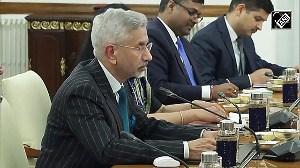It is fun to have fun but you have to know how, as the saying goes. That is precisely the problem with reducing exemptions.
All economists argue and even the finance ministry agrees that reducing exemptions is desirable but ultimately the net result is hardly productive. Most exemptions are due to inadequate appreciation of the economic realities and a proper will to remove exemptions.
It is not only the number of exemptions but also so many conditions and lists and certificates required that create serious problems in administering the exemptions. Structurally speaking, the largest number of exemptions happened because of the earlier prevailing high rates of duty.
Now that the rates for most industrial goods have come down to a peak rate of 12.5 per cent, it is far easier to abolish exemptions on a large scale. So Finance Minister P Chidambaram has a much simpler task compared to what Manmohan Singh had as finance minister in the early nineties when rates of duty were more than double of what they are now and so the quantum of exemption used to be much more.
Here are some specific suggestions on how to abolish exemptions.
Customs: The first decision that needs to be taken for industrial goods is that the present structure of rates of 15, 12.5, 10, 7.5, 5, 3, 2 and nil (all in percentage points) should be replaced by 10, 7.5, 5 and nil. This is on the assumption that the peak rate would come down to 10 per cent.
Once it is done, the second principle is not to give an exemption to the extent of 2.5 per cent or 5 per cent. There are several duties now, which are 7.5 per cent when the general rate is 10 per cent. Certainly, the industries can do without an exemption of 2.5 per cent.
Most exemptions are, however, to the extent of 5 per cent, that is, the difference between 10 per cent and 5 per cent. Industries can also very well do without an exemption to the extent of 5 per cent. So the full chapters should have only one rate of 10 per cent, or 7.5 per cent or 5 per cent and no other rate of duty in the same chapter or by exemption.
There have to be some exceptional cases such as the chapter on paper, which would attract 10 per cent while newsprint has to be 5 per cent. But such exceptions have to be very limited. This alone will eliminate the largest number of exemptions.
The third principle is to consciously follow the principle of "one chapter one rate". At present there are just 30 such chapters, which have one rate. It is quite possible to extend this number to 70 chapters in this Budget.
For the chemicals chapter, once the rates are reduced from 12.5 per cent to 10 per cent, the need to give an exemption by 5 per cent should not arise. That itself will eliminate all exemptions for chemicals. The whole paraphernalia of chemical tests will be practically eliminated. It will be a great relief to the importers.
The fourth principle is not only to make a particular chapter have one rate but also the related chapters have the same rate. For example, if chemicals attract 10 per cent, even chemical preparations and pharmaceuticals must attract 10 per cent. If resin attracts 10 per cent, then rubber also must have the same rate of duty.
The fifth principle is to remove the hidden subsidies enshrined in the exemptions for goods imported by railways, the metro rail, oil exploration, and so on. The machinery chapters, which account for the biggest amount of import, are replete with such exemptions. If the general rate for machinery becomes 10 per cent, there is no need to have another rate of 5 per cent for specific items of machinery, which create all the problems.
Sixth, there are exemptions for the telecommunication industry for manufacture of telecommunication grade optical fibre cables and fibre reinforced plastic products (FRP products).
This industry does not need protection, as it is a highly competitive and profit-making industry. So this exemption should be withdrawn. Seventh, the higher rates for agricultural goods can be combined at 150, 100 and 50 (in percentage points) in place of the present rates of 181, 105, 100, 85, 75, 70, 65, 60, 45, 40, 35, 30 and 25.
The next step is to advaloremise, that is, to introduce ad valorem rate in place of specific rates, which are now prevalent in textiles.
Last but not the least is to abolish the many conditions and certificates from different government authorities and elaborate "List of goods" for availing of exemptions. Condition number 5, which introduces control of the central excise authorities for the fulfilment of the conditions of exemptions, is prevalent for a very large number of exemptions over 13 chapters of the tariff.
This is an atrocity on manufacturer-importers who have to satisfy the central excise authorities about the fulfilment of the conditions. This goes against the principle of removing physical control and brings back the system of end use certificate from the backdoor.
In most cases only declarations should be sufficient because the rates of duty having come down, the propensity to misuse is much less now. And any aberration can be detected by the intelligence wing.
Excise: The present rates in central excise are 42, 37.5, 24, 16, 12 and 8 (in percentage points). To pave the path for Central GST, the Cenvat rate itself should come down from 16 per cent to 14 per cent.
This will eliminate the need for giving exemptions at the rate of 12 per cent. While next year a single rate of 14 per cent can be introduced, this year the rates can be made 24, 14 and 8 per cent. So the exemptions will automatically come down.
There are a number of exemptions at the rates of 8 and 12 per cent for such items as sugar, cereals, chemicals, rubber articles, fur skins, man-made filaments, footwear, umbrellas, metals and machinery. These exemptions should be abolished once the general rate becomes 14 per cent. The geographical exemptions, namely those given to the north east, Uttaranchal and so on, only aid revenue loss without any corresponding benefit.
They should be phased out by incorporating a sunset clause and no new industry should be allowed to avail of it.
Service Tax: The rate itself should be hiked to 14 per cent, which should be the same as the Cenvat duty of 14 per cent.
The most important element necessary for removing exemptions is for the finance minister to have the will to do so.
The writer is Member (retired), Central Board of Excise &Customs.






